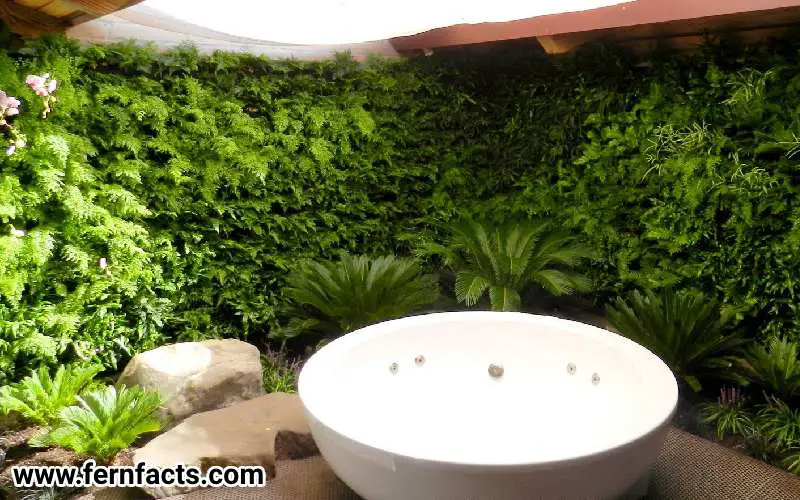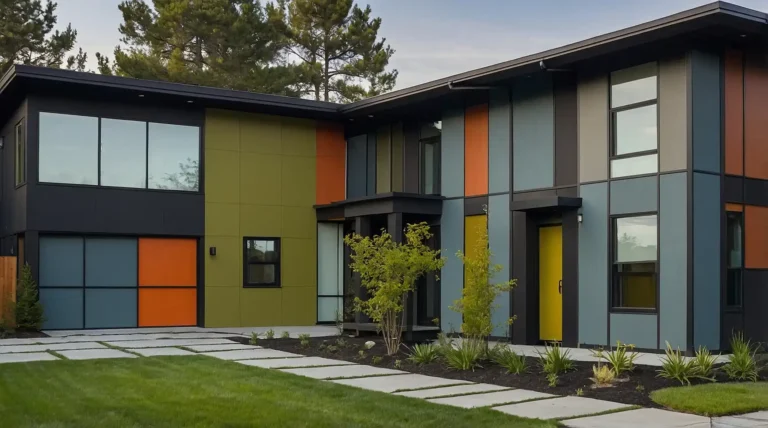How To Design Your Own Living Fern Wall
Do you want to make your home more nature-centric? Then creating a living wall with ferns will be great for you. A living wall with ferns will give you refreshments.
So here in this article, I’ll talk about how you can design your living wall with step-by-step guidelines. Apart from this, I’ll also share a list of ferns you can plant on your living wall.
So let’s start with the guidelines.
Materials That You Need:
- Vertical garden hanging pots (depending on the row size)
- Pair of gloves
- Hammers and nails
- Drill, screws
- Potting soil (vermiculite, perlite, moss, leaf mold)
- Vertical wall frame
- Varieties of ferns
How to Make Your Own Living Fern Wall: Step-by-Step Guidance
Now let’s make your beautiful living wall garden with ferns:
Step 1: Choose the Best Place
First, you need to choose the best place in your house that you’re going to change into a vertical wall garden.
Try to choose a bright indirect place where your ferns can get dappled sunlight, not direct sunlight. Most of the ferns prefer partial to fully shaded places to thrive.
That is why you must choose a site in your house that will give you a natural habitat look.
Step 2: Prepare the Background Wall
Living walls often get damper and moisture therefore the wall or background might get damaged. So you need to protect the background as well to make your living wall as magnificent as you want.
For that reason, try to keep a little distance from your home wall to your living garden wall. Make sure you use good quality paint for your wall so that the paint doesn’t get damaged.
Also weekly or monthly clean the background of the living wall to protect the home wall as well. Try to drain the water properly so that it doesn’t stain your wall.
Step 3: Place Your Vertical Wall Frame
Now secure your Vertical garden wall frame to your selected place. Make sure the wall doesn’t fall off easily. You can either choose any wooden frame or plastic or steel frame based on your convenience.
You can directly screw this wall into the wall by creating a good surface background.
Step 4: Fix Your Vertical Garden Pots
After placing that Frame, you need to secure your garden pots into that frame. According to row size, fit your pots into the row serially. Try to give a decent distance between each pot.
Secure them with screws and hammers. Make sure that they don’t fall off from the wall.
Step 5: Prepare Your Soil
Afterward, you have to prepare the potting soil. You can directly buy potting soil from the market.
Or else, you can make your soil at home by adding soil, perlite, vermiculite, leaf mold, peat moss, and sand.
Step 6: Plant Ferns in the Pockets
Now that you have prepared your soil, fill the posts with your potting soil in half. Later plant the ferns in the pots and fill the remaining soil.
Step 7: Water the Plants
After planting them in the pots, water all the ferns thoroughly. Try to give a good amount of water and make sure all the excessive water gets drained first.
Best Ferns List for Making Your Living Ferns Wall
Let’s go through some best ferns that you can choose to plant for your living fern wall.
1. Staghorn Ferns
- Botanic name: Platycerium bifurcatum
- Plant: Perennial evergreen
- Native range: Java, eastern Australia, New Guinea, Queensland, South Wales,
- Height: around 35 inches
- Shade: Partial
- Soil: acidic, neutral
- Hardiness zone: 9,10,11,12
Staghorn Ferns will look tremendously good on your living wall. Their unique deer-shaped fronds will look amazing on your garden wall.
2. Boston Fern
- Botanical name: Nephrolepis exaltata
- Plants: Evergreen
- Native range: America
- Shade requirements: partial shade or full shade
- Height: 20 to 98 inches
- Soil pH: acidic soil (6.0 to 6.5)
- Soil type: moist well-drained, drought-tolerant
- Hardiness zone: 10,11,12
Boston Fern’s evergreen fronds will also look good on your living fern wall. Their long, bushy fronds will enhance the garden’s look.
. As they are drought tolerant, they can be well adaptable in your living wall. Also, they will need lots of humidity around 80% to thrive.
3. Asparagus fern
- Botanical name: Asparagus setaceus
- Plants: evergreen perennial
- Native range: Southern Africa
- Native habitats: subtropical areas like rainfall
- Shade requirements: partial, fully shaded, bright place
- Height: around 3 feet tall and 4 feet wide
- Soil: slightly acidic (6.5 – 6.8), well-drained system
Asparagus ferns will be another great addition to your living fern wall. Their bright green textured foliage with different varieties will give your fern wall a vibrant appearance. Their small and tiny flowers will also enhance their whole appearance as indoor plants.
4. Hart’s Tongue Fern
- Botanical name: Asplenium scolopendrium
- Plants: Evergreen
- Native range: Northern hemisphere
- Native habitats: moist soil, damp crevices
- Shade requirements: partial to full shade
- Height: around 0.5 m
- Soil: alkaline or neutral,
Hart’s tongue ferns evergreen characteristics will also enhance your living wall appearance. Their fronds will last long throughout the season which will give your wall a greenery vibe.
Their unusual simple, strap-shaped undivided fronds enhance their overall look.
5. Maidenhair Spleenwort
- Botanic name: Asplenium trichomanes
- Plants: Evergreen
- Native range: mount regions and subarctic areas
- Shade requirements: Full or partial shade
- Height: up to 0.3 m
- Soil: neutral or alkaline and moist, well-drained.
Maidenhair spleenwort ferns are another small evergreen fern that will look tremendously beautiful on your living wall. Their tiny round-shaped fronds are bright green textured which also attracts the view.
6. Crocodile Ferns
- Botanical name: Microsorum musifolium
- Plants: Evergreen plant
- Native range: Southeastern, Asia, Australia
- Shade requirements: full or partial bright place
- Height: around 2 to 5 feet
- Soil type: rich-hu
- Hardiness zone: 9,10,11
Crocodile fern’s significant leathery textured foliage will also attract many plant lovers towards them. Since their leathery foliage seems like Crocodile which is reflected in their name as well.
Their beautiful long fronds come through the soil which grows from their rhizomes. It will also be great to attach to your living wall.
7. Bird’s Nest Ferns
- Botanical name: Asplenium nidus
- Plants: evergreen
- Native range: southeastern Asia, eastern Australia
- Shade requirements: partial to full shade
- Height: around 1 m
- Soil: alkaline or neutral
Bird’s nest ferns will also be an amazing addition to your living wall. Since their broad fronds are almost similar to banana leaves which is why they will also look good on the wall with other fern varieties.
8. Japanese Painted Fern
- Botanic name: Athyrium niponicum
- Native range: Eastern Asia
- Plant type: deciduous perennial
- Size: almost 1-3 ft tall
- light: bright and indirect sunlight or partial sunlight
- Soil: neutral acidic, alkaline, moist well drained
- USDA zone: 4,5,6,7,8,9
Japanese-painted ferns are known for their unique color transformation throughout the years. So their unique color compilation will be an eye-catching journey for you to witness.
Their unique silver foliage with pale greenish fronds will be a great compliment to your other green-textured ferns.
Wrap Up
In short, a living fern wall is a great thing for any plant lover to have in their house. By following the above-mentioned guidelines, you will be able to create your own fern wall at your house.
Also, some beautiful evergreen indoor ferns like staghorn ferns, Boston ferns, asparagus ferns, crocodile ferns, bird’s nest ferns, and Japanese-painted ferns will be great ferns to add to your living wall.
By creating your own living wall, you can enjoy the beauty of nature and wilderness in your house.






